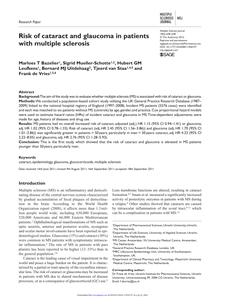Synthetic glucocorticoids are potent anti-inflammatory drugs but show dose-dependent metabolic side effects such as the development of insulin resistance and obesity. The precise mechanisms involved in these glucocorticoid-induced side effects, and especially the participation of adipose tissue in this are not completely understood. We used a combination of transcriptomics, antibody arrays and bioinformatics approaches to characterize prednisolone-induced alterations in gene expression and adipokine secretion, which could underlie metabolic dysfunction in 3T3-L1 adipocytes. Several pathways, including cytokine signalling, Akt signalling, and Wnt signalling were found to be regulated at multiple levels, showing that these processes are targeted by prednisolone. These results suggest that mechanisms by which prednisolone induce insulin resistance include dysregulation of wnt signalling and immune response processes. These pathways may provide interesting targets for the development of improved glucocorticoids.
DOCUMENT
Glucocorticoids (GCs), such as prednisolone (PRED), are widely prescribed anti-inflammatory drugs, but their use may induce glucose intolerance and diabetes. GC-induced beta cell dysfunction contributes to these diabetogenic effects through mechanisms that remain to be elucidated. In this study, we hypothesized that activation of the unfolded protein response (UPR) following endoplasmic reticulum (ER) stress could be one of the underlying mechanisms involved in GC-induced beta cell dysfunction. We report here that PRED did not affect basal insulin release but time-dependently inhibited glucose-stimulated insulin secretion in INS-1E cells. PRED treatment also decreased both PDX1 and insulin expression, leading to a marked reduction in cellular insulin content. These PRED-induced detrimental effects were found to be prevented by prior treatment with the glucocorticoid receptor (GR) antagonist RU486 and associated with activation of two of the three branches of the UPR. Indeed, PRED induced a GR-mediated activation of both ATF6 and IRE1/XBP1 pathways but was found to reduce the phosphorylation of PERK and its downstream substrate eIF2α. These modulations of ER stress pathways were accompanied by upregulation of calpain 10 and increased cleaved caspase 3, indicating that long term exposure to PRED ultimately promotes apoptosis. Taken together, our data suggest that the inhibition of insulin biosynthesis by PRED in the insulin-secreting INS-1E cells results, at least in part, from a GR-mediated impairment in ER homeostasis which may lead to apoptotic cell death.
DOCUMENT
The aim of the study was to evaluate whether multiple sclerosis (MS) is associated with risk of cataract or glaucoma. We conducted a population-based cohort study utilizing the UK General Practice Research Database (1987–2009) linked to the national hospital registry of England (1997–2008). Incident MS patients (5576 cases) were identified and each was matched to six patients without MS (controls) by age, gender, and practice. Cox proportional hazard models were used to estimate hazard ratios (HRs) of incident cataract and glaucoma in MS. Time-dependent adjustments were made for age, history of diseases and drug use.
DOCUMENT

Long-term care facilities are currently installing dynamic lighting systems with the aim to improve the well-being and behaviour of residents with dementia. The aim of this study was to investigate the implementation of dynamic lighting systems from the perspective of stakeholders and the performance of the technology. Therefore, a questionnaire survey was conducted with the management and care professionals of six care facilities. Moreover, light measurements were conducted in order to describe the exposure of residents to lighting. The results showed that the main reason for purchasing dynamic lighting systems lied in the assumption that the well-being and day/night rhythmicity of residents could be improved. The majority of care professionals were not aware of the reasons why dynamic lighting systems were installed. Despite positive subjective ratings of the dynamic lighting systems, no data were collected by the organizations to evaluate the effectiveness of the lighting. Although the care professionals stated that they did not see any large positive effects of the dynamic lighting systems on the residents and their own work situation, the majority appreciated the dynamic lighting systems more than the old situation. The light values measured in the care facilities did not exceed the minimum threshold values reported in the literature. Therefore, it seems illogical that the dynamic lighting systems installed in the researched care facilities will have any positive health effects.
DOCUMENT

Understanding taste is key for optimizing the palatability of seaweeds and other non-animal-based foods rich in protein. The lingual papillae in the mouth hold taste buds with taste receptors for the five gustatory taste qualities. Each taste bud contains three distinct cell types, of which Type II cells carry various G protein-coupled receptors that can detect sweet, bitter, or umami tastants, while type III cells detect sour, and likely salty stimuli. Upon ligand binding, receptor-linked intracellular heterotrimeric G proteins initiate a cascade of downstream events which activate the afferent nerve fibers for taste perception in the brain. The taste of amino acids depends on the hydrophobicity, size, charge, isoelectric point, chirality of the alpha carbon, and the functional groups on their side chains. The principal umami ingredient monosodium l-glutamate, broadly known as MSG, loses umami taste upon acetylation, esterification, or methylation, but is able to form flat configurations that bind well to the umami taste receptor. Ribonucleotides such as guanosine monophosphate and inosine monophosphate strongly enhance umami taste when l-glutamate is present. Ribonucleotides bind to the outer section of the venus flytrap domain of the receptor dimer and stabilize the closed conformation. Concentrations of glutamate, aspartate, arginate, and other compounds in food products may enhance saltiness and overall flavor. Umami ingredients may help to reduce the consumption of salts and fats in the general population and increase food consumption in the elderly.
MULTIFILE
